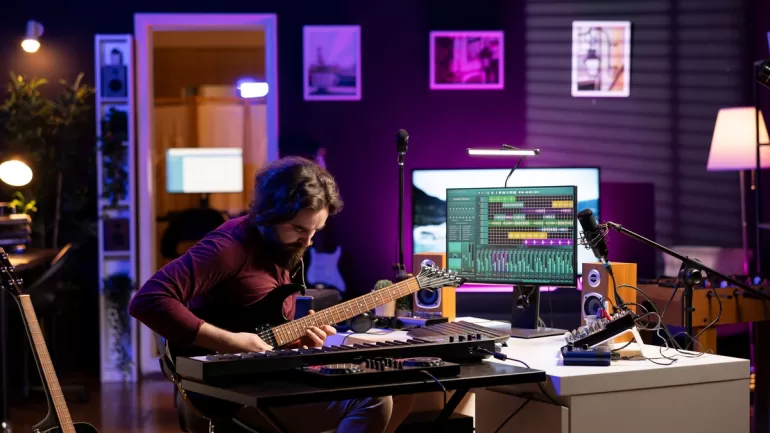MUSICIANS
Discover acoustic design secrets to achieve ideal home studio sound. Improve clarity, reduce echo, and create a professional mix space.
BY EMMA RADEBAUGH, ARTCENTRON
Top Acoustic Design Secrets for Home Studio Sound
You’ve bought the best microphone, preamps, and monitors for your home studio. You hit record, lay down what you think is a killer vocal track, but the playback sounds like you recorded it in an echoey bathroom. What gives? Get the crisp, professional sound you’re after.
Tame Reflections With Absorption Panels
Sound waves tend to bounce off flat surfaces, such as drywall, hardwood floors, and windows. Reflections create echo and reverb, making recordings sound muddy and distant.
Absorption panels are the first line of defense. You can place foam or fabric-covered panels at the primary reflection points in the room: the walls to your left and right, and the ceiling area between the speakers and your listening position. The panels soak up sound energy, stopping reflections to give you a much clearer sound.
Scatter Sound With Diffusion
While absorption is great for killing reflections, too much of it can make a room sound dead and unnatural. Diffusion helps scatter the remaining sound waves evenly throughout the space. This creates a sense of spaciousness without the nasty echo.
An acoustic design secret to building your ideal home studio is to buy specially designed wooden diffusers. They break up reflections, preventing sound from bouncing directly back to your ears for a more balanced listening environment. If you want to try an option with household items, add shelves filled with different-sized books. The books will work as a natural diffuser.
Isolate Your Monitors
Studio monitors can transfer vibrations to your desk or floor, which can color the sound and trick you into making poor mixing decisions. Decoupling the speakers from the surface they’re on is simple. You can use isolation pads, which are dense foam pads that sit under your monitors.
For a better solution, place your monitors on speaker stands and position them away from the desk at the perfect height for listening. These tweaks help you hear what’s actually in your mix.
Don’t Forget the Bass Traps
Low-frequency sound waves have a lot of energy and tend to build up in the corners of a room, causing a boomy, undefined low end. Bass traps are large, thick absorption panels specifically designed to soak up low-frequency energy. Place them in the corners of the room, making your kick drums punchy and the basslines clear.
You can also mount bass traps on the wall-ceiling corners for additional absorption. For larger rooms, consider adding freestanding bass traps to tame unruly frequencies further. These acoustic design secrets are a huge step toward improving your home studio sound.
You can fix your room’s acoustics without making it complicated or overly expensive. You can start by creating blueprints for your home project to visualize the best use of your space. Large prints can be a great way to design and construct your workspace from the beginning. Plan your studio with intention, focusing on solutions that fit your budget and your creative needs. Prepare to bring your vision to life!
